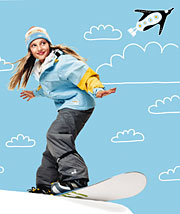
Be Safe
As temperatures drop and snow accumulations rise, active kids begin clamoring for old-fashioned winter fun. A few precautions can help ensure that children stay safe while playing outside. Dress kids in warm, water-resistant layers with a hat, scarf, and mittens. Make sure they take indoor breaks every 30 to 40 minutes, since children lose body heat faster than adults. (This also helps keep them feeling fresh — accidents often happen when kids are tired.) And have them drink water and wear sunscreen — dehydration and sunburn also occur in the winter. If safety gear is recommended for a specific sport, be certain kids are wearing it. (Our model was photographed in a studio, so the gear wasn't necessary.) Most important, children should always be supervised by adults.
Sledding and Tobogganing
To keep these favorite activities safe and enjoyable, the National Safe Kids Campaign in Washington, DC, reminds parents to double-check that their family's sled is free of jagged edges and that the handholds are sturdy. Review the manufacturer's recommendation to see how many children can ride at once. Teach kids to always sit with their feet forward — head and abdominal injuries occur more frequently when they lie down — and wear a helmet. The best place to sled is on packed snow, not ice, in an area that is free of obstacles and far away from traffic. Pick hills that end in flat planes, and always examine the hill for tree stumps or rocks that may be covered by snow. A designated area where the entire community goes sledding is best.
Ice-Skating
It's okay for kids as young as 4 to take a spin on the ice as long as they're steady walkers and can balance on one foot for more than 15 seconds. If possible, start young skaters on double blades. Skate only on solidly frozen surfaces that have been approved by the local police and recreational departments. (Check for signs around lakes and ponds.) Children should skate in the same direction as the crowd, avoid darting across the ice, and throw away gum or candy to prevent choking in case of falls. Some experts are now urging that skaters 6 and under wear helmets to prevent head injuries.
Skiing and Snowboarding
Children can hit the slopes at age 4 or 5, but they should take at least one professional skiing or snowboarding lesson first. Start beginners on an easy slope with gentle terrain — and insist that they wear sunglasses or goggles. Head injuries can be responsible for skiing and snowboarding deaths, says Stuart Weinstein, M.D., professor of orthopedic surgery at the University of Iowa in Iowa City and spokesman for the American Academy of Orthopedic Surgeons, so helmets specifically designed for skiing are a must. (Many ski schools now require that children 12 and under wear them.) Teach kids to use caution when entering and exiting the ski lift, be aware of others on the slope, avoid skiing too fast, and never ski alone. Snowboarders should use wristguards, since there is an increased risk of wrist fractures from falls when kids are learning, explains Jordan Metzl, M.D., medical director of The Sports Medicine Institute for Young Athletes in New York City.
Snowshoeing
In recent years, this sport has been gaining popularity with families. It's easy to do (you simply put on a pair of snowshoes and walk in the snow), kids as young as 3 can participate, and all you need is a snow-covered backyard or park. Be sure to dress children warmly and stay near them at all times.
Ice-Fishing
Frostbite is the top concern with ice-fishing — more so than with any other sport — because kids are sitting quietly in the cold for long periods of time, explains Dr. Metzl. (Don't assume your kids aren't getting frostbite just because you aren't.) As with ice- skating, use caution when selecting frozen surfaces, stick to approved areas, and supervise children carefully.
All content here, including advice from doctors and other health professionals, should be considered as opinion only. Always seek the direct advice of your own doctor in connection with any questions or issues you may have regarding your own health or the health of others.
Child
